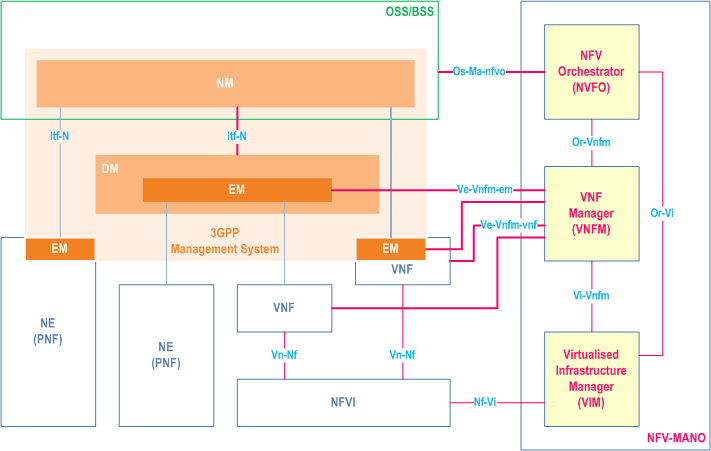Content for TS 28.500 Word version: 17.0.0
6 Management architecture
6.1 Overview
6.1.1 Management architecture
6.1.2 Functional blocks in the management architecture
6.2 Management interfaces
6.2.1 Overview
6.2.2 Itf-N
6.2.3 Os-Ma-nfvo
6.2.4 Ve-Vnfm-em and Ve-Vnfm-vnf
$ Change history
6 Management architecture p. 24
6.1 Overview p. 24
The following clauses elaborate the management architecture of mobile networks which include virtualized network functions and clarify the relationship between 3GPP management architecture and NFV-MANO framework (ETSI GS NFV-MAN 001 [3]).
The following clauses focus on the aspects of the NFV introduction in mobile network and the impacts to the existing 3GPP management system, which is composed of NM and DM/EM (as shown in Figure 6.1.1-1). Hence, they mainly address the functionalities to 3GPP management system and the requirements on the NFV-MANO through related reference points (i.e. Os-Ma-nfvo, Ve-Vnfm-em, Ve-Vnfm-vnf). They do not address any of the definitions of the NFV-MANO framework and interfaces. The detailed descriptions for those are in-scope of ETSI NFV documents, which are referred to below.
6.1.1 Management architecture p. 24
Figure 6.1.1-1 illustrates the management architecture of mobile networks that include virtualized network functions.

Physical mobile network management mainly relies on the interface Itf-N. With the introduction of NFV, mobile network management needs to also specify the virtualized network functions management. It involves not only one interface Itf-N, but also the interaction with NFV-MANO through defined reference points.
The management architecture in present document aligns with the NFV-MANO framework (ETSI NFV-MAN 001 [3]) with emphasis on the following aspects:
- Mobile network is composed of physical and virtualized network elements. Application-specific aspects of both VNFs and PNFs, corresponding to physical NEs, shall be managed by 3GPP management system.
-
The architecture identifies the following entities which are defined in TS 32.101, both of them are needed to extend the management functionalities for virtualized network and VNF:
- NM, which plays one of the roles of OSS/BSS and is the consumer of reference point Os-Ma-nfvo.
- DM/EM, if the EM includes the extended functionality, it can manage both PNF(s) and VNF(s).
-
The architecture identifies the following entities that share interfaces with NM, DM/EM and VNF:
- NFV Orchestrator (NFVO)
- VNF Manager (VNFM)
-
The architecture identifies the following main interfaces/reference points:
- Itf-N, the interface between NM and DM/EM
- Os-Ma-nfvo, the reference point between OSS/BSS and NFVO.
- Ve-Vnfm-em, the reference point between EM and VNFM.
- Ve-Vnfm-vnf, the reference point between VNF and VNFM.
6.1.2 Functional blocks in the management architecture p. 25
6.1.2.1 NM p. 25
NM plays one of the roles of OSS/BSS. It provides the functions for the management of mobile network which includes virtualized network functions. The NM supports FCAPS management functions of the mobile network (e.g. IMS, EPC) and 3GPP service (e.g. data service, voice service) and supports the management of mobile network lifecycle. NM initiates the lifecycle management of ETSI-defined NS and VNF, which are related to mobile network, through interaction with NFV-MANO.
6.1.2.2 EM/DM p. 25
EM/DM is responsible for FCAPS management functionality for a VNF on an application level and physical NE on a domain and element level. This mainly includes:
- Fault management for VNF and physical NE.
- Configuration management for VNF and physical NE.
- Accounting management for VNF and physical NE.
- Performance measurement and collection for VNF and physical NE.
- Security management for VNF and physical NE.
- Request the lifecycle management operation for a VNF to VNFM.
- Exchange of information regarding the VNF and Virtualized Resources associated with the VNF.
6.1.2.3 NFV-MANO p. 25
NFV-MANO is composed of NFV Orchestrator (NFVO), VNF Manager (VNFM) and VIM. The main functionalities of those are defined in ETSI GS NFV-MAN 001 [3].
6.1.2.4 NFVI p. 25
NFVI is composed of the hardware and software components that together provide the infrastructure resources where VNFs are deployed. The infrastructure resources contain the hardware resources, virtualization layer software and the virtualized resources which the VNF relies on. The main functionalities are defined in ETSI GS NFV-MAN 001 [3].
6.2 Management interfaces p. 26
6.2.1 Overview p. 26
The following clauses describe the high level functionalities of the Itf-N interface, the Os-Ma-nfvo, Ve-Vnfm-em and Ve-Vnfm-vnf reference points from 3GPP perspective.
6.2.2 Itf-N p. 26
The interface is used for FCAPS exchanges between NM and EM/DM, which includes both VNF and physical NE FCAPS management functions.
6.2.3 Os-Ma-nfvo p. 26
This reference point is used for NS lifecycle management, NS performance management, NS fault management, NSD management and VNF Package management produced by NFVO as defined by ETSI GS NFV-IFA 013 [9].
6.2.4 Ve-Vnfm-em and Ve-Vnfm-vnf p. 26
These reference points are mainly used for VNF lifecycle management, the information delivery of VNF and VR failure or performance measurement information and virtualization configuration, etc.